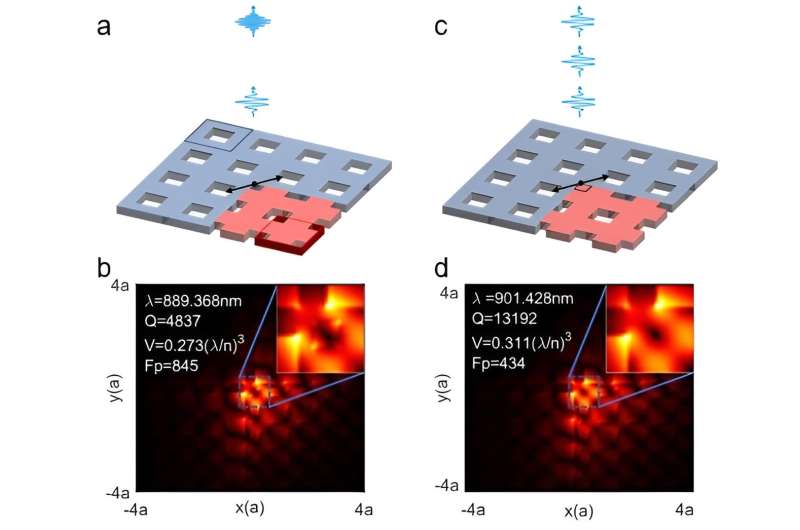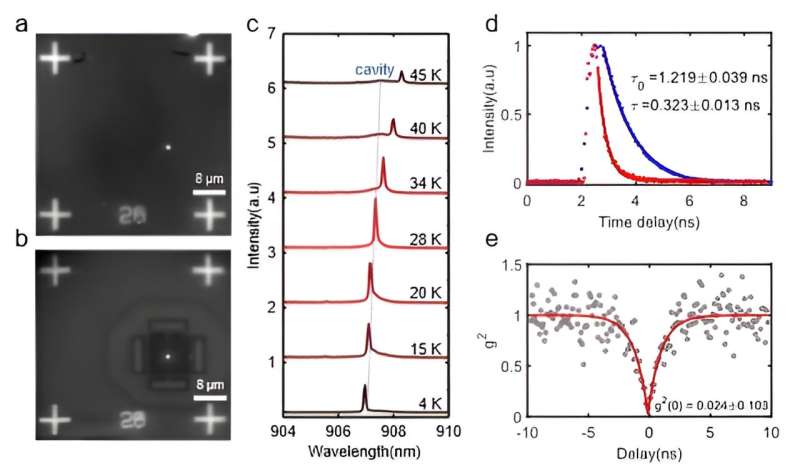This article has been reviewed according to Science X's editorial process and policies. Editors have highlighted the following attributes while ensuring the content's credibility:
fact-checked
peer-reviewed publication
proofread
A single photon emitter deterministically coupled to a topological corner state

Exploring cavity quantum electrodynamics (cQED) is pivotal for advancing quantum technology and unraveling the fundamental intricacies of light-matter interactions. A prevalent strategy involves integrating a single quantum emitter into photonic microcavities boasting high-quality (Q) factors or small mode volumes. The strength of the coupling in cQED is often assessed using the Purcell factor, a vital parameter.
Semiconductor quantum dots (QDs) in the solid state emerge as promising candidates due to their atom-like two-energy structure and compatibility with contemporary semiconductor fabrication processes for microcavity integration. However, challenges arise from structural disorder or defects introduced during the fabrication process, detrimentally affecting performance.
In this context, topological optics emerge as a promising solution owing to their intrinsic topological robustness. The higher-order topological corner state, offering a smaller mode volume, yields a higher Purcell factor or vacuum Rabi splitting, even with a modest Q factor.
Nevertheless, challenges persist in coupling single QDs to highly confined topological cavities, primarily due to the random spatial distribution of QDs during their growth process. Previous attempts faced difficulties in achieving a significant enhancement of light-matter interactions.
In a recent publication in Light: Science & Applications, the research team led by Prof. Ying Yu and Prof. Jianwen Dong from Sun Yat-sen University demonstrate the initial deterministic coupling of a single QD to a topological corner state. This achievement leverages topological robustness to modify the structure, employing a wide-field photoluminescence (PL) imaging technique. Through resonance, they observe a notable Purcell factor of 3.7 and polarized single-photon emission.
The structure is devised based on the 0D corner state, a characteristic of a slab-type second-order topological photonic crystal (PhC). The PhC's band topology stems from the quantized edge dipolar polarization, marked by a 2D Zak phase.
The PhC structure adopts a distinctive unit cell definition with a square lattice, depicted by the red and blue regions in Fig. 1a. Consequently, the Zak phases corresponding to each region differ. Combining these distinct PhCs, as shown in Fig. 1a, gives rise to a corner state, a convergence of the two sets of 1D interface polarization, as depicted in Fig. 1b.
However, in this cavity, the single QD is positioned in close proximity to the dry-etched surface, which may lead to spectral diffusion or blinking due to coupling with surface states and charge traps. To tackle this concern, the design is adjusted by eliminating the center airhole, as illustrated in Fig. 1c.
As the corner state is inherently guaranteed by the topological property of edge dipolar polarization, it remains unaffected by weak perturbations, such as the removed airhole. Fig. 1d illustrates the corner state profile with the center hole reinstated. After reinstating the center hole, the corner state remains almost intact, featuring a higher Q factor, a modest mode volume, and a larger distance (~100 nm) between the QD and the etched surface.

Experimentally, the topological cavity is deterministically fabricated around the target QD using a wide-field PL imaging technique. Figs. 2a–b showcase the PL images of the device before and after cavity fabrication, clearly revealing the targeted single QD (bright spot) at the center of the created corner state.
By adjusting the temperature, the target QD is fine-tuned across the resonance of the corner state, as illustrated in Fig. 2c. A Purcell factor of approximately 3.7 is demonstrated when the QD resonates with the corner state, as shown in Fig. 2d. A Hanbury Brown and Twiss correlation measurement is conducted to assess the single photon purity, indicating a low multi-photon probability of g(2)(0) ~ 0.024 ± 0.103.
In summary, the researchers demonstrate the initial deterministic coupling of a single QD with a corner state, leveraging topological robustness and precise positioning techniques. Through temperature tuning, they achieve an on-resonance Purcell factor of 3.7.
The device also exhibits polarized single-photon emission with a single photon purity g(2)(0) as low as 0.024 ± 0.103. This breakthrough expands the potential of higher-order topological phases for advanced applications in manipulating light-matter interactions at the quantum level.
More information: Mujie Rao et al, Single photon emitter deterministically coupled to a topological corner state, Light: Science & Applications (2024). DOI: 10.1038/s41377-024-01377-6
Journal information: Light: Science & Applications
Provided by TranSpread





















